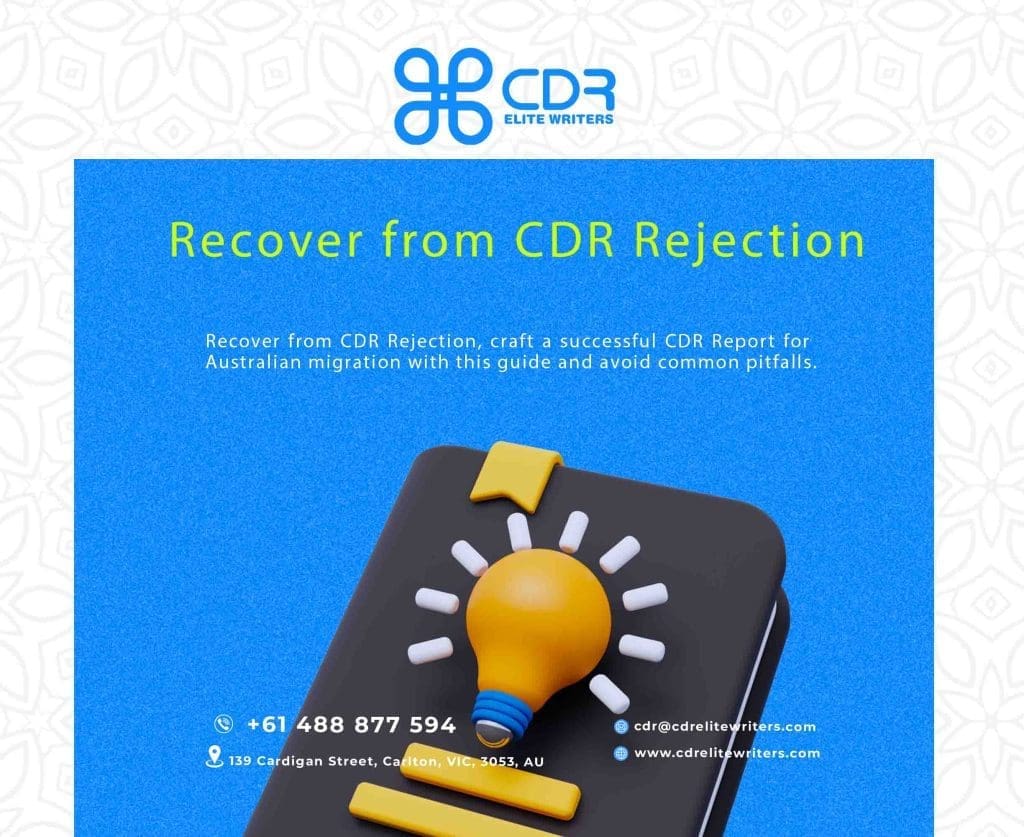Introduction
Receiving a CDR Rejection can be a pivotal moment for engineers aspiring to immigrate to Australia. It is imperative to approach this rejection with a strategic mindset, recognizing it as a critical opportunity to refine one’s presentation of competencies in alignment with the stringent criteria set forth by Engineers Australia.
This article aims to provide a structure for transforming CDR Rejection into a robust plan for success. We will dissect the components of effective feedback utilization, elucidate best practices for addressing shortcomings, and delineate actionable steps to enhance your CDR Report’s comprehensiveness and impact.
Table of Contents

Common Reasons for CDR Rejection
- Insufficient Evidence of Competency: Failure to provide concrete examples that clearly demonstrate the claimed competencies in alignment with applicable engineering categories.
- Inadequate Problem-Solving Exemplification: Lack of detailed narratives describing the engineering challenges faced, the methodologies employed, and the specific roles played in arriving at a solution.
- Noncompliance with Formatting Standards: Non-adherence to the prescribed CDR Report format, including the structuring of Career Episodes, CDR Summary Statement, and the Continuing Professional Development (CPD) list.
- Ambiguity in Technical Terminology or Language: Use of overly technical jargon without adequate explanation or poor language proficiency, limiting the assessor’s ability to discern the applicant’s professional capabilities.
Revising Your CDR Report Based on Feedback
The process of revising your Competency Demonstration Report (CDR) in response to feedback necessitates a diligent and structured approach. Follow these steps to ensure your revision meets the stringent criteria of Engineers Australia:
- Comprehensive Re-Evaluation – Reassess your original CDR Report submission in its entirety, comparing it with the feedback received. Highlight the areas that have been identified as lacking and require amendments.
- Prioritization of Issues – Prioritize the revisions depending on the severity and extent of the issues pointed out. Focus primarily on rectifying major errors that could significantly affect the assessment outcome before attending to less critical comments.
- Corrections to Technical Content – Address inaccuracies or ambiguities in the technical content of your Career Episodes. Ensure that the correct technical terms, units of measurement, and engineering principles are applied coherently and consistently throughout.
- Enhanced Narration – Refine the narrative aspects of your Career Episodes to present a coherent story of your professional development and engineering problem-solving capabilities. This includes providing a clearer context, more detailed descriptions of your role, and better articulation of the outcomes.
- Revised CDR Summary Statement – Update the CDR Summary Statement to align it with any changes made to the Career Episodes. Double-check that each indicator and element referenced corresponds accurately to the correct paragraph in the Career Episodes.
- Professional Development Reassessments – Revisit your Continuing Professional Development (CPD) list, ensuring that it accurately reflects up-to-date and relevant professional activities that demonstrate your commitment to maintaining technical skills and knowledge.
- Format Realignment – Ensure that your revised CDR strictly adheres to the formatting standards, guidelines, and structures specified by Engineers Australia.
- Proofreading and Language Polishing – Conduct a meticulous proofread of your revised document to correct grammar, punctuation, and spelling errors. Ensure that the language used is clear, professional, and understandable to a non-specialist audience.
- External Review – Consider engaging an independent expert review service to provide objective analysis and critique of your revised CDR. This step can help identify any overlooked deficiencies and provide assurance of the document’s quality.
- Final Adjustment and Submission – Incorporate all feedback and suggested improvements into the final version of your CDR. Compile the document in accordance with all the CDR Report requirements and prepare it for resubmission.
By methodically following these steps, you will significantly improve your CDR and demonstrate your unwavering commitment to meeting the high standards of the engineering profession in Australia. Remember, a well-articulated and compliant CDR can be a pivotal factor in securing a positive outcome from Engineers Australia.
Ensuring Alignment with Engineers Australia Guidelines
To guarantee the acceptance of your Competency Demonstration Report (CDR) by Engineers Australia, it is imperative to meticulously ensure that your document conforms to their established guidelines.
As of the year 2020, Engineers Australia assessed over 12,000 CDRs for migration purposes, and it has been reported that approximately 32% of these applications received a negative outcome due to a variety of shortcomings, including failure to follow the Migration Skills Assessment Handbook.
In aligning your Competency Demonstration Report (CDR) to meet the precise guidelines set forth by Engineers Australia, consider the following authoritative instructions:
- Guideline Familiarization – Initiating the process requires an exhaustive understanding of the Migration Skills Assessment Booklet published by Engineers Australia. Immerse yourself in the guidelines to ensure no aspect of the CDR Report requirements remains unaddressed.
- Templates and Samples Review – Engineers Australia sometimes provides templates and samples which should be used as benchmarks for format and content structure. Never directly copy these examples; instead, use them to guide the construction of your original content.
- Explicit Requirement Adherence – Break down the CDR Report into its fundamental components: Career Episodes, Summary Statement, and Continuing Professional Development. Each section has detailed specifications on length, focus, and structure. Ensure each meets the individual requirements to the letter.
- Competency Element Correlation – Meticulously cross-reference every claim of engineering competency with the correct paragraphs in your Career Episodes. Engineers Australia provides a list of competency elements for every occupational category—Skilled and precise referencing cannot be understated.
- Engineering Language Precision – Use discipline-specific language that reflects your engineering specialization. Incorporate terminology that is both technically accurate and adheres to the professional tenor expected by Engineers Australia.
- Outcome Focus – Your Career Episodes should emphasize the engineering problems tackled and the solutions provided. This includes the application of specific engineering methodologies and the results achieved, showing clear evidence of personal engineering competency.
- CPD Relevance – Select only those CPD activities which are relevant and current in relation to your applied engineering category. The CPD list should exemplify a commitment to lifelong learning and staying abreast of advancements in the engineering field.
- Document Scrutiny – Prior to submission, rigorously review every component of your CDR Report for compliance with the Engineers Australia guidelines. This includes checking for accuracy of data, the relevance of content, and thematic coherence.
Consequences of Ignoring CDR Feedback
Neglecting feedback in the revision of your Competency Demonstration Report (CDR) can have profound implications, ranging from minor queries to outright rejection by Engineers Australia. Understanding these ramifications is essential:
- Rejection Risk Amplification – Disregarding feedback significantly increases the probability of your CDR being rejected upon evaluation. Engineers Australia values the integration of constructive criticism as it demonstrates a commitment to excellence and continuous professional development.
- Credibility Erosion – Failing to address identified weaknesses or errors may lead to questioning of your technical acumen and attention to detail. Such oversights undermine your credibility and may suggest a lack of integrity or diligence, traits highly valued in the engineering profession.
- Visa Application Delays – An inadequate response to feedback typically leads to additional review cycles, causing substantial delays in the visa application process. This can affect your migration plans and career opportunities, leading to potential financial and emotional distress.
- Opportunity Costs – Time spent correcting avoidable mistakes post-submission could have been invested in furthering your engineering career, either through actual work experience or acquiring new competencies. This represents not just a delay, but a loss of potential professional advancement.
- Professional Image Impact – The professional image you project to the assessing authorities and future employers is tarnished when feedback is overlooked. A well-crafted CDR Report Sample that heeds critical advice is not only a requirement but a reflection of your professional persona in the global engineering community.
Conclusion
In conclusion, the meticulous preparation of your Competency Demonstration Report (CDR) adhering to Engineers Australia’s stringent guidelines is not merely a procedural step, but a critical milestone in your pursuit of an engineering career in Australia. It demands an understanding of detailed expectations, a proactive approach to avoiding CDR rejection. By diligently following the instructions outlined, you position yourself to achieve a positive assessment, thereby accelerating your migration process.




